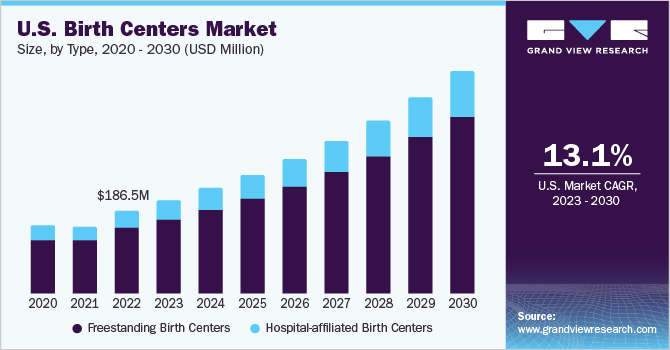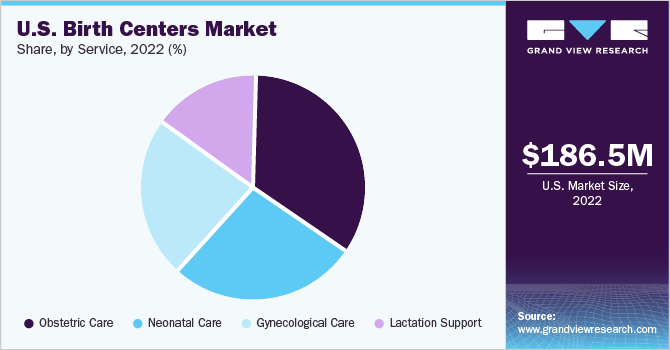- Home
- »
- Healthcare IT
- »
-
U.S. Birth Centers Market Size, Share & Trends Report, 2030GVR Report cover
![U.S. Birth Centers Market Size, Share & Trends Report]()
U.S. Birth Centers Market (2023 - 2030) Size, Share & Trends Analysis Report By Type (Freestanding Birth Centers, Hospital-affiliated Birth Centers), By Service (Obstetric Care, Neonatal Care), And Segment Forecasts
- Report ID: GVR-4-68040-086-1
- Number of Report Pages: 60
- Format: PDF
- Historical Range: 2017 - 2021
- Forecast Period: 2023 - 2030
- Industry: Healthcare
- Report Summary
- Table of Contents
- Segmentation
- Methodology
- Download FREE Sample
-
Download Sample Report
Market Size & Trends
The U.S. birth centers market size was valued at USD 186.5 million in 2022 and is estimated to grow at a compound annual growth rate (CAGR) of 13.1% over the forecast period from 2023 to 2030. Improved health outcomes and significantly lower costs associated with birth centers are likely to drive the demand for these services. Birth centers provide a more natural and personalized approach to childbirth, with a focus on a homelike environment and midwifery care. According to the American Association of Birth Centers, there are currently over 400 birth centers, including both freestanding and hospital-affiliated birth centers, in operation in the U.S. Some of the factors contributing to the rising demand for birth centers in the U.S. include a growing interest in natural childbirth and an increasing demand for more personalized care.

Birth centers also have a number of advantages for both mothers and babies, such as lower intervention rates such as cesarean sections and epidurals, as well as a more positive overall birth experience. Despite the growing demand for birth centers, they still account for a small percentage of all childbirth facilities in the U.S.
The costs of a normal delivery at birth centers are roughly half of those of a hospital delivery as the duration of the mother and baby's stay in a birth center is significantly shorter and involves no doctors or anesthesia. Birth centers are not intended for complicated pregnancies that necessitate costly services. Women who want to give birth without the use of pain relievers such as epidurals and women with low-risk pregnancies prefer birth centers. Pregnant women, who are over 35 years of age, are having multiple babies, have high blood pressure in the pre-delivery phase, or have diabetes, are excluded from birth centers, as these conditions require continuous medical attention.
The COVID-19 pandemic had a positive impact on the birth centers market. While the pandemic had led to some challenges, it had also highlighted the need for more flexible and personalized options for childbirth. The pandemic increased the burden on treatment sensitivity and healthcare services for critically ill patients and led to an increase in interest in alternative birth options. Many women were concerned about the risk of exposure to the virus in hospital settings, leading them to consider birth centers or home birth options. The rising prevalence of COVID-19 in various states, the rapid increase in COVID-19-infected patients in hospitals, and the high risk of infection for pregnant mothers are some of the factors contributing to the growth of the market.
The demand for birthing facilities increased significantly during the pandemic, as they were more affordable, culturally knowledgeable, and safer. The overall health outcome was positive in birth centers as compared to hospitals. Birth centers provide personalized and customized rooms with great safety, privacy, and freedom. The recovery time is also less which is 4 to 8 hours in birthing centers compared to 24 to 48 hours in hospitals due to the use of few medicines. Most birth centers have partnerships with local hospitals so that they can transfer the patient if any complications occur during delivery.
Ronald Reagan UCLA Medical Center (UCLA Health), Barnes-Jewish Hospital, Rose Medical Center, Cedars-Sinai Medical Center (Cedars-Sinai), Cleveland Clinic, Prisma Health Baptist Parkridge Hospital, The Mount Sinai Hospital, and TriStar Centennial Women's and Children’s Hospital are some of the key players due to their financial performances and strong product portfolios. The players are adopting strategies such as acquisitions, mergers, partnerships, and product launches, and also remain prominent drivers of growth. For instance, in April 2022, Carrum Health, Inc., a digital company that provides a technological platform to connect employees and employers to the Center of Excellence (CoE), announced a partnership with The Minnesota Birth Center to launch its maternity care benefit program. The partnership will enable the provision of an extensive maternity care program for low-risk babies and their moms, including delivery & labor and postpartum & prenatal care, at a single cost for self-insured employers.
Type Insights
Based on type, the birth centers are segmented into freestanding birth centers and hospital-affiliated birth centers. In 2022, the freestanding birth centers segment accounted for the highest revenue share of 78.9% and is expected to grow at the fastest CAGR over the forecast period. Key factors responsible for the largest segment share include the growing presence of freestanding birth centers in the country, affordability, and a home-like birth environment that attracts more and more customers.
In addition, growing investments by investment firms and venture capitalists in building new birth centers, especially in rural areas, is also expected to significantly influence market growth. The key players are launching services that are more affordable and convenient to the customers, thereby propelling market growth.
Service Insights
Based on services, the market is segmented into obstetric care, neonatal care, gynecological care and lactation support. In 2022, the obstetric care segment accounted for 34.6% of the revenue share and is expected to grow at the fastest CAGR over the forecast period. Some of the key factors contributing to the segment growth include the high demand for maternal care services, especially during the pandemic period.

The number of deaths in pregnant women is on the rise due to pregnancy or delivery complications, resulting in an increasing demand for specialty obstetric care provided by birth centers. There are more chances of experiencing conditions like cardiac arrest, uterine rupture, and severe bleeding when the baby is delivered through cesarean delivery. The risk of these outcomes increases due to cesarean delivery. Therefore, the number of pregnant women opting for obstetric care services at birth centers is growing significantly.
Key Players & Market Share Insights
The key players in the U.S. birth centers market are adopting strategies such as acquisitions, mergers, collaboration, and partnerships, to expand their market footprint. Several players are attempting to put demand-friendly strategic plans into action. The development of new services and high R&D investments to promote natural deliveries are some of the strategies being implemented by market players. Key players are also collaborating with healthcare firms to address the issue of prenatal and postnatal care for patients in the country. For instance, in May 2021, Oula Health, Inc., a maternity center providing midwifery and obstetrics care, announced a partnership with Mount Sinai West, a full-service medical center with a 24/7 emergency department. As a result of this collaboration, Oula Health, Inc. patients who receive postpartum, birthing, and prenatal care through the company's remote care platform and collaborative team will be able to avail these services at Mount Sinai. Some of the prominent players in the U.S. birth centers market include:
-
Ronald Reagan UCLA Medical Center (UCLA Health)
-
Barnes-Jewish Hospital
-
Rose Medical Center
-
Cedars-Sinai Medical Center (Cedars-Sinai)
-
Cleveland Clinic
-
Prisma Health Baptist Parkridge Hospital
-
The Mount Sinai Hospital
-
TriStar Centennial Women's and Children’s Hospital
-
Lenox Hill Hospital (Northwell Health)
-
The Mother Baby Center
-
St. David's Women's Center of Texas
-
Norton Women's and Children's Hospital
-
NewYork-Presbyterian Hospital
-
The BirthPlace Santa Monica (UCLA Health)
-
Hospital of the University of Pennsylvania
-
Houston Methodist Hospital
-
The Johns Hopkins Hospital
-
Massachusetts General Hospital
-
Mayo Clinic
-
Northwestern Memorial Hospital
-
NYU Langone Hospitals
-
Rush University Medical Center
-
Stanford Health Care’s Lucile Packard Children’s Hospital Stanford
-
University of Michigan Hospitals-Michigan Medicine
-
UCSF Medical Center
-
UCLA Medical Center
U.S. Birth Centers Market Report Scope
Report Attribute
Details
Revenue forecast in 2030
USD 494.5 million
Growth rate
CAGR of 13.1% from 2023 to 2030
Base year for estimation
2022
Historic data
2017 - 2021
Forecast period
2023 - 2030
Quantitative units
Revenue in USD million, and CAGR from 2023 to 2030
Report coverage
Revenue forecast, company share, competitive landscape, growth factors & trends
Segments covered
Type, service
Key companies profiled
Ronald Reagan UCLA Medical Center (UCLA Health); Barnes-Jewish Hospital; Rose Medical Center; Cedars-Sinai Medical Center (Cedars-Sinai); Cleveland Clinic; Prisma Health Baptist Parkridge Hospital; The Mount Sinai Hospital; TriStar Centennial Women's and Children’s Hospital; Lenox Hill Hospital (Northwell Health); The Mother Baby Center; St. David's Women's Center of Texas; Norton Women's and Children's Hospital; NewYork-Presbyterian Hospital; The BirthPlace Santa Monica (UCLA Health); Hospital of the University of Pennsylvania; Houston Methodist Hospital; The Johns Hopkins Hospital; Massachusetts General Hospital; Mayo Clinic; Northwestern Memorial Hospital; NYU Langone Hospitals; Rush University Medical Center; Stanford Health Care’s Lucile Packard Children’s Hospital Stanford; University of Michigan Hospitals-Michigan Medicine; UCSF Medical Center; UCLA Medical Center
Customization scope
Free report customization (equivalent up to 8 analysts working days) with purchase. Addition or alteration to country, regional, and segment scope.
Pricing and purchase options
Avail customized purchase options to meet your exact research needs. Explore purchase options
U.S. Birth Centers Market Report Segmentation
This report forecasts revenue growth and provides an analysis of the latest trends in each of the sub-segments from 2017 to 2030. For this study, Grand View Research has segmented the U.S. birth centers market report based on type, and service:
-
Type Outlook (Revenue, USD Million, 2017 - 2030)
-
Freestanding Birth Centers
-
Hospital-affiliated Birth Centers
-
-
Service Outlook (Revenue, USD Million, 2017 - 2030)
-
Obstetric Care
-
Neonatal Care
-
Gynecological Care
-
Lactation Support
-
Frequently Asked Questions About This Report
b. The U.S. birth center market was estimated at USD 186.5 million in 2022 and is expected to reach USD 208.5 million in 2023.
b. The U.S. birth center market is expected to grow at a compound annual growth rate of 13.1% from 2023 to 2030 to reach USD 494.5 million by 2030. This can be attributed by an increasing demand for personalized and family-centered maternity care options among expectant parents.
b. The freestanding birth center segment accounted for 78.9% of revenue share in 2022. The segment dominated the market owing to various initiatives pertaining to the development of treatment alternatives for unnatural birth, an increase in awareness about birth complications, and funding provided for the development of maternal care services.
b. Some of the key market players operating in the market are Ronald Reagan UCLA Medical Center (UCLA Health), Barnes-Jewish Hospital, Rose Medical Center, and Cedars-Sinai Medical Center (Cedars-Sinai), among others.
b. The market is driven by various factors such as improved health outcomes, and notably lower costs associated with birth center care as compared to hospitals. Additionally, growing government programs and growing efforts by major players to develop products that target these niche segments portend a potential future for development.
Share this report with your colleague or friend.
Need a Tailored Report?
Customize this report to your needs — add regions, segments, or data points, with 20% free customization.

ISO 9001:2015 & 27001:2022 Certified
We are GDPR and CCPA compliant! Your transaction & personal information is safe and secure. For more details, please read our privacy policy.
Trusted market insights - try a free sample
See how our reports are structured and why industry leaders rely on Grand View Research. Get a free sample or ask us to tailor this report to your needs.










